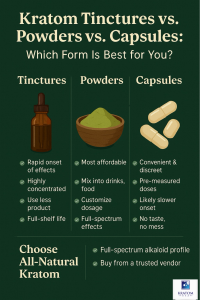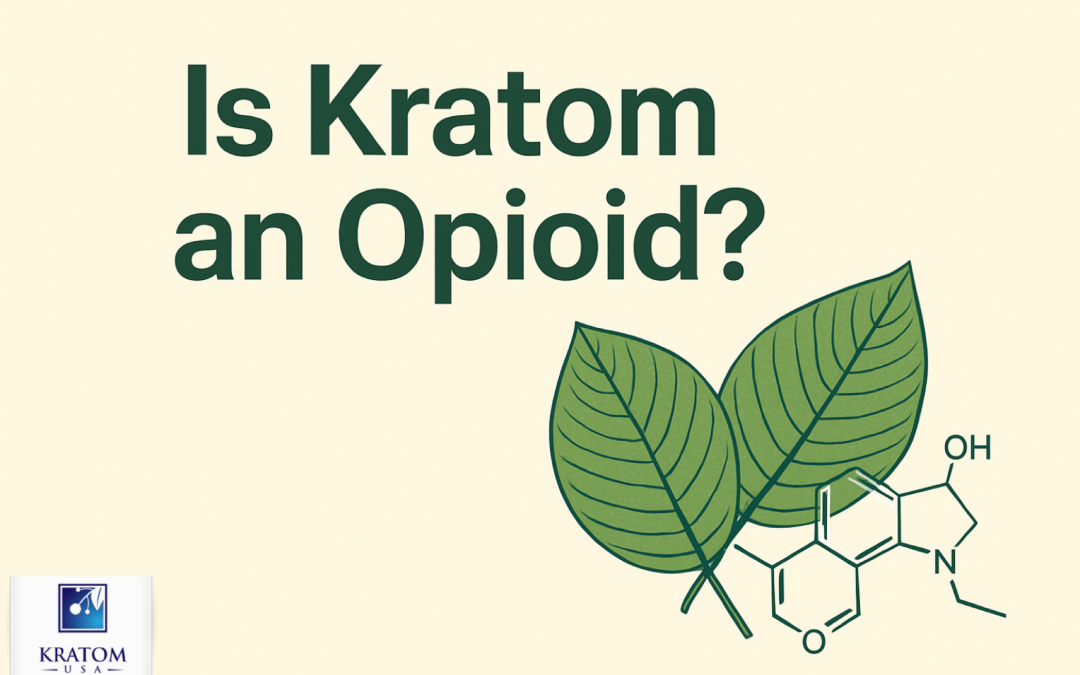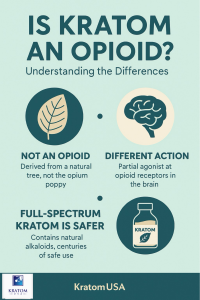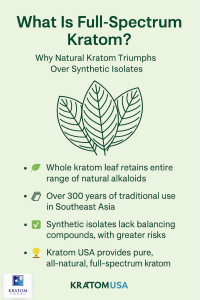
by KratomUSA | Sep 17, 2025 | Kratom
🌿 How to Choose the Safest, Most Reliable Source for All-Natural, Full-Spectrum Kratom
If you’re looking to buy kratom online, it’s easy to get overwhelmed by the number of vendors claiming to offer “the best” products. But not all kratom is created equal—and not all vendors are trustworthy. Knowing how to spot a reputable kratom seller could mean the difference between a safe, effective experience and a disappointing (or even dangerous) one. In this article, we’ll walk you through exactly what to look for in a trustworthy kratom vendor—and the red flags to avoid. We’ll also spotlight Kratom USA, one of the longest-standing, most reputable sellers in the industry, with nearly 20 years of experience offering natural, full-spectrum kratom.
✅ Key Points
-
Not all kratom vendors follow safe sourcing and testing practices
-
Trustworthy vendors provide lab results, transparency, and customer support
-
Avoid kratom vendors that don’t disclose origins or testing
-
Kratom USA has built a reputation over two decades for quality and safety
-
Always prioritize organic, full-spectrum kratom over synthetic isolates
🌿 What Makes a Kratom Vendor Trustworthy?
 🔬 1. Third-Party Lab Testing
🔬 1. Third-Party Lab Testing
A legitimate vendor will always provide independent third-party lab results. These tests should confirm:
-
Alkaloid content (e.g., mitragynine levels)
-
Absence of contaminants like heavy metals, mold, salmonella, and pathogens
-
Batch-specific results for transparency
If a vendor doesn’t offer lab results—or only offers vague “quality tested” claims—that’s a red flag.
📍 2. Transparent Sourcing
Reputable kratom vendors will clearly state:
-
Where their kratom is grown (e.g., Indonesia, Malaysia, Thailand)
-
Their relationship with local farmers
-
How it’s harvested and processed
Kratom USA, for instance, sources all-natural kratom leaves directly from trusted Southeast Asian farms with ethical harvesting methods and careful drying processes.
📦 3. Freshness, Packaging, and Storage
Proper storage is critical to preserving kratom’s potency. A quality vendor will:
-
Use air-tight, UV-resistant packaging
-
Store kratom in climate-controlled facilities
-
Rotate inventory regularly to ensure freshness
Powder should be finely ground, not dull or clumpy.
💬 4. Real Customer Support & Reviews
Can you reach a human if you have a problem? Can they answer your questions?
-
Trustworthy vendors offer customer support via email or phone
-
They feature verified buyer reviews
-
Their website has clear policies on shipping, returns, and safety
🚩 What to Avoid: Red Flags in the Kratom World
-
❌ No lab testing or vague “high quality” claims
-
❌ Ultra-cheap pricing that seems too good to be true
-
❌ No information about where the kratom comes from
-
❌ Misleading labels like “legal high,” “synthetic kratom,” or “7-hydroxymitragynine isolate”
-
❌ No customer service or reviews
🌱 Why Natural, Full-Spectrum Kratom Is the Better Choice
Full-spectrum kratom contains over 40 active alkaloids, working together to create a balanced, synergistic effect. When isolated alkaloids—like synthetic 7-hydroxymitragynine—are used alone, they can:
-
Feel overly intense or unnatural
-
Cause unpredictable side effects
-
Lack the nuanced benefits of natural kratom
Kratom USA only sells all-natural, full-spectrum kratom that honors centuries of safe, traditional use. Their products are:
-
Ethically sourced
-
Lab-tested
-
Additive-free
-
Never synthetic
🏆 Why Kratom USA Is a Vendor You Can Trust
With nearly two decades of experience and a strong reputation, Kratom USA stands out in the industry for:
-
✅ Consistently clean lab results
-
✅ A deep respect for kratom’s native traditions
-
✅ Friendly, knowledgeable customer service
-
✅ Same-day shipping on orders placed before 2 p.m. EST
-
✅ A wide variety of natural powders, capsules, and tinctures
🗣️ Real Customer Feedback
“I’ve tried several kratom vendors, but Kratom USA has been the most consistent by far. Their kratom feels clean and smooth, and their customer service is excellent.”
— Ashley R., Florida
“As someone who’s used kratom for years, I can tell you this is the real deal. Not synthetic, no weird effects. Just natural, strong, reliable kratom.”
— Mark T., Texas
📌 Key Takeaways
-
Always choose kratom vendors that test for safety and potency
-
Look for transparency, sourcing details, and verified reviews
-
Avoid synthetic isolates—go full-spectrum and all-natural
-
Kratom USA has a proven track record of excellence
❓ FAQ: Choosing the Right Kratom Vendor
Is cheap kratom safe?
Not necessarily. Cheap kratom is often low-quality, contaminated, or not tested. You get what you pay for.
What does “full-spectrum” kratom mean?
It means the product contains all of kratom’s natural alkaloids, not just one isolated compound.
Are synthetic kratom products dangerous?
Many synthetic products lack safety oversight and can produce unpredictable or overly intense effects. Always choose natural.
How do I know if a vendor is legit?
Check for lab results, real customer reviews, transparent sourcing, and clear contact info.
Why choose Kratom USA?
They’ve been a trusted vendor for nearly 20 years, offering clean, natural, lab-tested kratom with excellent customer service.

by KratomUSA | Sep 10, 2025 | Kratom
🌿 Choose the Right Kratom for Your Lifestyle
Choosing the right form of kratom can dramatically impact your experience—whether you’re using it for focus, relaxation, or physical wellness. So what’s the best way to take it? Kratom tinctures vs. powders vs. capsules: which form is best for you? In this article, we’ll break down the differences between these popular formats, how they affect your body, and why natural, full-spectrum kratom—especially from trusted vendors like Kratom USA—should be your go-to for quality and safety.
🔑 Key Points
-
Powder, capsules, and tinctures each offer unique benefits and convenience levels
-
Tinctures are fast-acting and highly concentrated
-
Capsules are discreet and easy to dose
-
Powder is versatile and budget-friendly
-
Full-spectrum kratom delivers a balanced alkaloid profile
-
Always choose natural kratom from a trusted source like Kratom USA
🌿 Kratom Powders: The Original and Most Flexible Format
Kratom powder is made by drying and finely grinding the leaves of the Mitragyna speciosa tree. It’s been used for centuries in Southeast Asia by farmers, laborers, and herbalists for a natural energy boost, pain relief, and mood enhancement.
Benefits of kratom powder:
-
✅ Easy to mix into teas, smoothies, or capsules
-
✅ Offers the purest, full-spectrum experience
-
✅ Cost-effective for regular users
-
✅ Provides control over dosage
Many traditional users prefer powder for its authenticity. If you enjoy rituals like tea-making, this might be your favorite form.
 💊 Kratom Capsules: Convenient and Discreet
💊 Kratom Capsules: Convenient and Discreet
Capsules are simply kratom powder sealed in a gel cap, offering convenience for people on the go. They’re ideal for users who don’t like the taste of kratom or want a mess-free option.
Benefits of kratom capsules:
Keep in mind: capsules may take slightly longer to kick in since your body must digest the outer shell first.
💧 Kratom Tinctures: Potent and Fast-Acting
Kratom tinctures are liquid extracts made by soaking kratom leaves or powder in alcohol or another solvent to extract alkaloids like mitragynine and 7-hydroxymitragynine.
Benefits of tinctures:
⚠️ Important note: Some tinctures on the market are made with synthetic or isolated alkaloids, which can lack the balance and safety of full-spectrum kratom. Always read the label and buy from a reputable source.
🌱 Why Full-Spectrum, All-Natural Kratom Is Better
Full-spectrum kratom retains the entire alkaloid profile of the leaf. This includes over 40 different compounds that work synergistically (the “entourage effect”) for a smoother, more effective experience.
Benefits of full-spectrum kratom:
-
🌿 Balanced effects: no sudden crashes or overstimulation
-
🌿 Historically safe: used safely for hundreds of years in Southeast Asia
-
🌿 Fewer side effects vs. isolates or synthetic versions
Isolated alkaloids (like 7-hydroxymitragynine) may create intense effects but can also increase the risk of side effects or tolerance buildup. That’s why Kratom USA only offers natural, full-spectrum kratom—tested for purity, safety, and consistency.
🛡️ Why Trust Kratom USA?
Kratom USA has been a leader in the industry for nearly 20 years. Their products are:
-
✅ 100% natural and full-spectrum
-
✅ Lab-tested for purity and potency
-
✅ Backed by thousands of satisfied customers
-
✅ Shipped same day (before 2 p.m. EST) for ultimate convenience
Visit KratomUSA.com to explore a wide variety of premium kratom tinctures, powders, and capsules.
🧑💬 What Real Users Say
“I tried capsules first, but now I use the tincture when I need fast relief. I trust Kratom USA because I know I’m getting natural kratom.”
– Amanda R., Asheville, NC
“I use powder daily in tea—it helps me stay balanced without relying on caffeine. Kratom USA’s Green Maeng Da is my go-to.”
– James T., Phoenix, AZ
❓ FAQ: Kratom Formats Explained
❓ What is the fastest-acting form of kratom?
Tinctures are usually the fastest because they absorb directly into the bloodstream under the tongue.
❓ What’s the most beginner-friendly format?
Capsules are great for beginners because of the precise dosing and lack of bitter taste.
❓ Is powder more effective than capsules?
They are equally effective by volume, but powder may be absorbed slightly faster and is more flexible.
❓ Are all tinctures full-spectrum?
No! Some tinctures are made with isolated alkaloids, which lack the balance of natural kratom. Always check labels and buy from trusted vendors like Kratom USA.
❓ Which kratom form lasts the longest?
All forms last about the same in terms of effects, but powder and capsules may have slightly longer onset and duration than tinctures.
🔚 Final Thoughts
There’s no one-size-fits-all when it comes to kratom formats—but knowing the differences empowers you to choose what suits your body and lifestyle. Whether you enjoy the flexibility of powder, the ease of capsules, or the potency of tinctures, natural full-spectrum kratom from Kratom USA delivers quality you can trust.

by KratomUSA | Sep 7, 2025 | Kratom
🌿 Exploring how kratom compares to caffeine for clean energy, focus, and wellness
Coffee and energy drinks are daily staples for millions—but they’re not for everyone. With jittery crashes, gut issues, and sleep disruption, many are searching for a smoother way to stay energized. That’s where kratom enters the conversation. But is kratom a natural alternative to coffee or energy drinks? Let’s break down how kratom compares to caffeine, what makes it unique, and why some people are turning to this ancient Southeast Asian leaf for a cleaner, more balanced boost.
✅ Key Points
-
Kratom and caffeine both stimulate alertness but work through different mechanisms.
-
Unlike caffeine, kratom interacts with opioid receptors—though it’s not an opioid.
-
Natural kratom offers a more gradual onset and fewer crashes than most energy drinks.
-
Full-spectrum kratom may support motivation, mood, and even pain relief.
-
Choosing a trustworthy vendor like KratomUSA.com ensures safe, all-natural kratom.
☕ Caffeine: The World’s Most Popular Pick-Me-Up
Caffeine, found in coffee, tea, and energy drinks, works by blocking adenosine receptors in the brain. This prevents drowsiness and increases alertness—but it also raises heart rate, increases acid production in the stomach, and leads to energy crashes once it wears off.
For some, caffeine causes:
-
Shakiness or anxiety
-
Trouble sleeping
-
Stomach irritation
-
Blood pressure spikes
🍃 What Is Kratom and How Does It Work?
Kratom (Mitragyna speciosa) is a tropical tree native to Southeast Asia. Traditionally, farmers in countries like Thailand and Indonesia chewed the leaves to fight fatigue, boost productivity, and ease muscle soreness after long days of labor.
Kratom contains naturally occurring alkaloids—primarily mitragynine and 7-hydroxymitragynine—that interact with the body’s opioid receptors, though in a far milder and more complex way than pharmaceutical opioids.
💡 According to a 2022 review published in Frontiers in Pharmacology, kratom users report increased energy, focus, and mood enhancement—especially at lower doses, typically 1 to 3 grams.
⚖️ Kratom vs. Caffeine: A Wellness-Based Comparison
| Feature |
Kratom (Low Dose) |
Caffeine |
| Primary effect |
Mental clarity, energy, mood |
Alertness, nervous energy |
| Duration |
4–6 hours |
2–4 hours |
| Crash effect |
Minimal (if any) |
Common, can feel jittery/tired |
| Additional benefit |
May ease discomfort, uplift mood |
Appetite suppressant, metabolism boost |
| Tolerance risk |
Moderate with overuse |
High with daily use |
🌿 Why People Are Replacing Their Morning Coffee with Kratom
 Testimonials from kratom users often highlight:
Testimonials from kratom users often highlight:
“I stopped drinking coffee because the jitters were too much. Now I take a small amount of green vein kratom in the morning and feel mentally sharp without the crash.” – Lindsey R., FL
“Kratom gives me this steady focus that helps me get through hours of writing or meetings. I used to rely on energy drinks, but kratom feels cleaner.” – Josh M., TX
Kratom—especially green vein strains like Green Maeng Da or Green Malay—is gaining popularity among high-performers who want stimulation with more balance.
🔬 Is Kratom Safer Than Energy Drinks?
Energy drinks are loaded with sugar, synthetic caffeine, and artificial flavors. According to the CDC, excessive consumption of these drinks has been linked to:
In contrast, full-spectrum natural kratom, when sourced responsibly and used in moderation, has a centuries-long track record of safe traditional use.
🛒 Why Sourcing Matters: Only Trust Natural Kratom Vendors
Unfortunately, the rise of kratom’s popularity has also led to questionable products—some containing synthetic additives or isolated alkaloids like 7-hydroxymitragynine in unnaturally high concentrations.
This is why it’s crucial to choose a vendor that:
-
Offers lab-tested, all-natural kratom
-
Follows Good Manufacturing Practices (GMP)
-
Has a long-standing reputation in the kratom community
👉 Kratom USA has been a trusted leader in premium, organic kratom for nearly 20 years. All products are naturally harvested, free of synthetics, and third-party tested for safety.
✨ Final Thoughts
If you’re looking for a cleaner, more natural energy source, kratom may be worth exploring. While it’s not a one-size-fits-all solution, many people find it delivers smooth, sustained focus without the crash, making it a viable alternative to coffee and energy drinks. Just remember to source your kratom from a reputable vendor like KratomUSA.com and start with low doses to see how your body responds.
❓ FAQ: Kratom vs. Caffeine
Q: Can kratom replace my morning coffee?
A: For many people, yes—especially green vein kratom in low doses. It offers focus and clarity without the jittery side effects of caffeine.
Q: Is kratom addictive like caffeine?
A: Kratom can be habit-forming with daily high doses, just like caffeine. Responsible, moderate use helps reduce that risk.
Q: What strain of kratom is best for energy?
A: Green strains like Green Maeng Da or White Thai are often favored for clean stimulation and mental focus.
Q: Is it legal to use kratom for energy?
A: Kratom is legal in most U.S. states. Always check your local laws and buy from a trusted, compliant source.
Q: How does KratomUSA ensure purity and safety?
A: KratomUSA lab-tests every batch and adheres to strict quality control to ensure you receive 100% all-natural kratom—no synthetics, no fillers.

by KratomUSA | Aug 29, 2025 | Kratom
🌿 Why Full-Spectrum, All-Natural Kratom Is a Safer Alternative to Opioids
The question “Is kratom an opioid?” has sparked growing interest among researchers, health professionals, and the kratom community. Kratom, derived from the leaves of the Mitragyna speciosa tree native to Southeast Asia, has been traditionally used for centuries to support energy, ease discomfort, and promote wellness. While some of its alkaloids, particularly mitragynine and 7-hydroxymitragynine, interact with the body’s opioid receptors, kratom itself is not classified as an opioid in the traditional pharmaceutical sense. Understanding the difference between synthetic opioids and naturally occurring kratom can help consumers make informed choices about its safety, legality, and benefits. In this article, we’ll explore the pharmacology, historical use, and current research around kratom to clarify where it really stands.
🧩 Key Points
-
Kratom is not a traditional opioid, though it interacts with the same receptors.
-
Its key alkaloids—mitragynine and 7-hydroxymitragynine—act differently from pharmaceutical opioids.
-
Full-spectrum kratom contains 40+ alkaloids, which work together to reduce the risk of side effects or dependency.
-
Natives in Southeast Asia have used natural kratom for hundreds of years with a strong safety profile.
-
Synthetic isolates or enhanced kratom extracts can increase risks not seen in natural kratom use.
🧪 What Is Kratom?
Kratom (Mitragyna speciosa) is a tropical evergreen tree native to Southeast Asia, particularly Thailand, Malaysia, and Indonesia. The leaves have been used for centuries by local populations as a natural remedy for fatigue, pain, and low mood. Traditionally, kratom is consumed in its natural leaf or powder form, brewed into tea, chewed raw, or ground and encapsulated.
❓ So, Is Kratom an Opioid?
No, kratom is not an opioid by medical or chemical standards. However, it interacts with the mu-opioid receptors in the brain—similar to traditional opioids. This interaction has led to some confusion in media headlines and regulatory conversations.
That said, kratom’s key alkaloids behave very differently than drugs like morphine or oxycodone:
| Feature |
Kratom (Natural) |
Traditional Opioids |
| Source |
Leaf of a natural tree |
Opium poppy (natural or synthetic) |
| Receptor Binding |
Partial agonist |
Full agonist |
| Respiratory Depression |
Very low risk |
High risk |
| Addiction Potential |
Lower with full-spectrum kratom |
High |
| Duration of Use |
Hundreds of years, traditionally |
Modern use began ~150 years ago |
🧠 According to a 2022 article published in Frontiers In Pharmacology—kratom’s main compound—binds to opioid receptors without causing significant respiratory depression, a hallmark danger of traditional opioids.
🧬 What Makes Kratom Different from Opioids?
 Kratom is considered an “atypical opioid” because:
Kratom is considered an “atypical opioid” because:
-
Partial Activation: It only partially activates opioid receptors, meaning a ceiling effect exists where higher doses don’t lead to proportionately stronger effects (or overdose).
-
Multifunctional Alkaloids: Aside from mitragynine and 7-HMG, kratom contains dozens of other alkaloids like paynantheine and speciogynine that modulate its effects.
-
No Synthetic Additives: Natural kratom in powder or capsule form doesn’t include additives or synthetic compounds—unlike some pharmaceutical products.
🌿 The Case for Full-Spectrum, Organic Kratom
When consumed in its natural form, kratom offers a balanced profile of over 40 bioactive compounds. These compounds work synergistically to:
✅ Promote energy, focus, or relaxation depending on the strain
✅ Minimize harsh side effects often seen with isolates
✅ Reduce the risk of dependency and withdrawal
“I’ve used natural green vein kratom daily for two years to manage stress and minor pain. I’ve never felt addicted—just stable and focused.”
— Alisha T., Verified Kratom USA Customer
Isolated alkaloids like 7-hydroxymitragynine—sometimes found in synthetic kratom products—are often more potent and riskier, with effects that more closely resemble prescription opioids.
🧭 Why Source Matters: Choose Natural, Trusted Kratom
One of the most important decisions a consumer can make is to purchase from a trusted vendor that sells only all-natural, lab-tested kratom.
Kratom USA has been a leader in the industry for nearly 20 years, offering:
-
✅ Full-spectrum, organic kratom
-
✅ No synthetic additives or alkaloid isolation
-
✅ Transparent lab testing
-
✅ Same-day shipping on orders before 2 p.m. EST
🧠 Summary
Kratom is not an opioid, even though it interacts with some of the same brain receptors. In its natural, full-spectrum form, kratom is considered far safer and has a much longer history of safe use than many synthetic or enhanced products.
The growing popularity of kratom in the U.S. is directly tied to its ability to support well-being without the harsh risks of pharmaceutical alternatives—but only when used responsibly and purchased from a reputable source like Kratom USA.
❓FAQ
Is kratom safe?
Yes, when used responsibly and in its natural form, kratom has a long-standing safety record, especially in its countries of origin.
Can kratom be addictive?
Full-spectrum kratom has a lower risk of dependence than traditional opioids, but like coffee or other botanicals, moderation is key.
Why do some say kratom is an opioid?
Because its main alkaloids partially activate opioid receptors, some researchers refer to it as an “atypical opioid,” but chemically and legally, it is not classified as an opioid.
Is natural kratom better than synthetic?
Absolutely. Natural kratom provides the full spectrum of alkaloids that work together to promote balance and safety—unlike synthetic isolates which may increase potency and risk.

by KratomUSA | Aug 28, 2025 | Kratom
🌿 Full-Spectrum Kratom is the Best Choice
Kratom has gained widespread attention for its unique ability to offer both stimulation and relief—depending on the dose and strain. But not all kratom products are created equal. In today’s fast-growing market, full-spectrum kratom stands apart for its natural, unaltered profile of alkaloids—unlike synthetic isolates, which focus narrowly on single compounds like 7-hydroxymitragynine. This article explores what full-spectrum kratom is, why it’s safer, and how its historical use in Southeast Asia supports its time-tested benefits.
🔑 Key Points at a Glance
-
Full-spectrum kratom retains the plant’s entire range of natural kratom alkaloids, not just one.
-
Indigenous Southeast Asian cultures have used whole kratom leaves for centuries.
-
Synthetic isolates lack the balancing compounds found in natural kratom and may pose greater risks.
-
Kratom USA offers pure, all-natural, full-spectrum kratom with nearly 20 years of trusted service.
-
Choosing a reputable kratom vendor is essential to ensure safety, efficacy, and authenticity.
🌱 What Is Full-Spectrum Kratom?
 Full-spectrum kratom refers to kratom products made from the entire leaf, without isolating or enhancing any single compound. The plant naturally contains over 40 alkaloids, including mitragynine, paynantheine, and speciogynine—each contributing uniquely to its overall effects.
Full-spectrum kratom refers to kratom products made from the entire leaf, without isolating or enhancing any single compound. The plant naturally contains over 40 alkaloids, including mitragynine, paynantheine, and speciogynine—each contributing uniquely to its overall effects.
Unlike lab-manipulated extracts, full-spectrum kratom preserves the natural ratios found in the raw leaf. This allows the alkaloids to work synergistically, promoting a more balanced, stable experience with fewer side effects.
🧪 What Are Synthetic Kratom Isolates?
Synthetic isolates are made by extracting or artificially reproducing a single compound—most commonly 7-hydroxymitragynine, which is known for its potent opioid-like activity. While this may sound beneficial on the surface, isolates can lead to intensified effects and increased risk of dependency or side effects.
📜 A Brief History of Natural Kratom Use
Kratom has been used for over 300 years in countries like Thailand, Indonesia, and Malaysia. Traditionally, farmers and laborers would chew the leaves or brew them into a tea to combat fatigue, relieve pain, and enhance endurance during long workdays.
Historical texts and ethnobotanical records document how kratom was also used socially and ceremonially. Importantly, these uses always involved the whole leaf, not isolated alkaloids.
Today, millions of people around the world use natural kratom for:
✅ Why Full-Spectrum Kratom Is Safer
Here’s why full-spectrum kratom remains the preferred choice among long-term users and experts:
-
Balanced Alkaloid Profile: Compounds like speciogynine and corynantheidine help counteract the intensity of 7-hydroxymitragynine.
-
Lower Abuse Potential: Studies suggest that full-spectrum kratom has mild withdrawal symptoms, far less than opioids or isolates.
-
Historical Safety Record: Indigenous use over hundreds of years supports its safety when taken naturally.
🧠 “I’ve tried isolates before, and they were too intense. Full-spectrum kratom from Kratom USA is smoother, more predictable, and never leaves me foggy.”
— Jason P., Verified Buyer
🛡️ Why You Should Buy From a Trusted Vendor
When shopping for kratom, it’s essential to look for lab-tested, full-spectrum products from established vendors. KratomUSA.com is one of the oldest kratom companies in the U.S., offering nearly two decades of quality, naturally grown kratom.
They never spike products with synthetic isolates, and every batch is tested for:
-
Alkaloid profile
-
Heavy metals
-
Microbial contaminants
🛍️ Explore Full-Spectrum Kratom at KratomUSA.com
📊 Full-Spectrum vs. Synthetic: Quick Comparison
| Feature |
Full-Spectrum Kratom |
Synthetic Isolates |
| Contains all alkaloids |
✅ Yes |
❌ No |
| Synergistic effects |
✅ Balanced |
❌ One-sided |
| Historical usage |
✅ 300+ years |
❌ None |
| Safety profile |
✅ Lower risk |
❌ Higher risk |
| Lab-manipulated |
❌ No |
✅ Yes |
🙋♀️ What Real Users Say
“I trust Kratom USA because I know I’m getting a full-spectrum product that hasn’t been tampered with. I’ve been using their Green Maeng Da for over 4 years now.”
— Dawn R., Florida
“After trying isolates, I came back to natural kratom. The difference is huge. Full-spectrum feels more natural and less jittery.”
— Marcus L., Texas
📝 Key Points Recap
-
Full-spectrum kratom includes all natural alkaloids for a holistic effect.
-
Synthetic isolates can be overly potent and come with higher risks.
-
Historical use supports kratom’s safety—especially in its natural form.
-
KratomUSA.com is a trusted source for safe, full-spectrum kratom.
-
Always choose natural, lab-tested products from reputable vendors.
❓ FAQ: Full-Spectrum Kratom vs. Isolates
What does “full-spectrum kratom” mean?
It means the product contains the entire alkaloid profile found naturally in kratom leaves—nothing added or removed.
Is full-spectrum kratom safer than extracts?
Yes. Full-spectrum kratom is less likely to cause side effects, as it preserves the natural balance of alkaloids that help moderate the experience.
Why are synthetic isolates riskier?
Isolates like 7-hydroxymitragynine can be highly concentrated, increasing the risk of tolerance, side effects, and dependence.
Can I trust kratom vendors online?
Only if they are transparent about testing and avoid synthetic additives. Kratom USA is one of the longest-standing, most respected vendors in the industry.
How long has full-spectrum kratom been used?
For more than three centuries, full-spectrum kratom has been consumed in its whole-leaf form throughout Southeast Asia.

 🔬 1. Third-Party Lab Testing
🔬 1. Third-Party Lab Testing


 💊 Kratom Capsules: Convenient and Discreet
💊 Kratom Capsules: Convenient and Discreet
 Testimonials from kratom users often highlight:
Testimonials from kratom users often highlight:
 Kratom is considered an “atypical opioid” because:
Kratom is considered an “atypical opioid” because:
 Full-spectrum kratom refers to kratom products made from the entire leaf, without isolating or enhancing any single compound. The plant naturally contains over 40 alkaloids, including mitragynine, paynantheine, and speciogynine—each contributing uniquely to its overall effects.
Full-spectrum kratom refers to kratom products made from the entire leaf, without isolating or enhancing any single compound. The plant naturally contains over 40 alkaloids, including mitragynine, paynantheine, and speciogynine—each contributing uniquely to its overall effects.